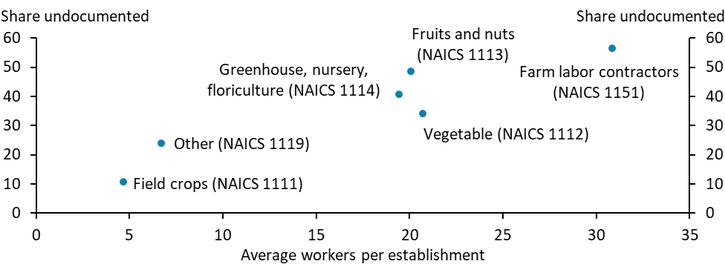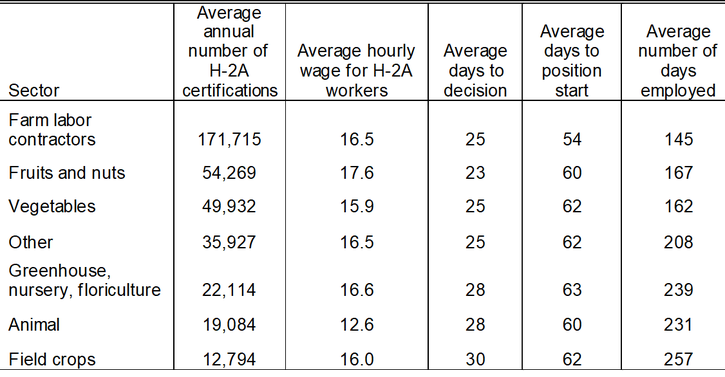Labor shortages in U.S. agriculture have been a persistent challenge. Historically, the industry has depended on foreign-born workers to complement—and, at times, substitute for—native-born labor (Charlton and Taylor 2016). Today, about 70 percent of workers in the U.S. farm sector are foreign born, and many of these workers hold visas or are undocumented (Charlton 2024; Martin and Rutledge 2025).
Farms have varying labor needs, and specialty crop growers rely heavily on laborers in general and undocumented workers in particular. The horizontal axis of Chart 1 shows that greenhouse growers, vegetable growers, and producers of fruits and nuts require significantly more workers than producers of field crops such as corn, soybeans, and wheat. Specialty crop growers also use a higher share of undocumented workers. The vertical axis of Chart 1 shows that undocumented workers account for 30 to nearly 50 percent of workers in greenhouse, vegetable, and fruit and nut operations compared with just 10 percent of workers in field crop operations._ Although farm labor contractors (FLCs), which function similarly to temporary staffing agencies, have the highest share of undocumented workers, these contractors are used more frequently by specialty crop growers, further contributing to their reliance on undocumented workers._
Chart 1: Farm labor contractors and specialty crop growers use a higher share of undocumented workers

Notes: Average workers per establishment are estimated using data from the Quarterly Census of Earnings and Wages (QCEW) from 2018 to 2022 for all private-sector employment within the indicated North American Industry Calssification System (NAICS) code. Shares of undocumented workers are estimated using data from the National Agricultural Workers Survey (NAWS) from 2017 to 2022. Details about the calculations are provided in an online data supplement. See also Hill and Javier (2025).
Sources: U.S. Bureau of Labor Statistics (BLS) and U.S. Department of Labor.
Historically, the supply of U.S.-born farm workers has not been sufficient to meet demand for farm jobs at the going wage rate, contributing to a largely foreign-born workforce. Farms could reduce their reliance on foreign-born and undocumented farm workers by using automation to reduce labor needs or by replacing undocumented workers with temporary visa holders through the H-2A temporary agricultural workers program (Martin 2018; Huffman 2012). However, these strategies are likely to be more costly and time-consuming. Despite the growing adoption of harvest machinery for produce used by the food-processing industry, machines able to preserve the quality of fresh produce demanded by U.S. consumers are still rare. In addition, while the H-2A program is widely used by farms to supply seasonal farm labor, hiring H-2A workers typically requires more foresight and would likely be more expensive than employing undocumented workers.
Participation in the H-2A program requires employers to pay predetermined wages and provide other employment benefits. To hire an H-2A worker, the Department of Labor first requires farmers to demonstrate unsuccessful attempts to recruit workers already residing in the United States for open positions. Employers must pay for workers’ housing in the United States, their transportation from their home country to the United States, and their daily transportation to the work site. Additionally, employers must pay wages above the Adverse Effect Wage Rate (AEWR), which is set according to regional average hourly wages for farm workers and is necessarily at or above the applicable minimum hourly wage. As shown in Table 1, the average hourly wage for H-2A workers neared $18 for H-2A workers in the fruit and nut sector from 2018 to 2022, compared with the sector-wide average of $14.50 reported by the latest National Agricultural Workers Survey. Hourly wages for H-2A workers and costs for transportation, housing, and food have continued to rise since this period._
Table 1: Summary of H-2A workers by sector

Notes: Table shows summary statistics from the authors’ own analysis of H-2A visa certifications programmatic data from the U.S. Office of Foreign Labor Certifications. Details about the calculations can be found in our online data supplement.
Sources: U.S. Department of Labor and authors’ calculations.
Other aspects of the H-2A program may also limit its effectiveness as an immediate alternative to the current labor pool. Table 1 shows that the approval process for H-2A workers (“average days to decision” plus “average days to position start”) takes up to 92 days from petition to employment, a significant delay for farms that operate within specific planting and harvesting windows. Farmers who rely on contracted labor or who cultivate fruits, vegetables, flowers, and nuts already employ a greater number of H-2A workers than field crop operations and tend to hire them for shorter periods.
Some segments of the U.S. agricultural sector—for example, fruit and vegetable production—are especially sensitive to changes in the supply of foreign-born labor. Farm operators can adapt to labor supply changes in a variety of ways, each with trade-offs. Some operators may substitute foreign-born or undocumented workers with capital investments or by further hiring H-2A workers, though these alternatives are likely to be more costly and introduce delays. Others may reduce U.S. production of labor-intensive commodities, potentially shifting to other crops or expanding production in other countries.
Endnotes
-
1
The National Agricultural Workers Survey does not currently include H-2A visa workers in their sampling frame, so these estimates of undocumented shares do not account for the estimated 17 percent of U.S. farmworkers with an H-2A visa (Ayoub 2024b).
-
2
Crop support activities (NAICS 1151) primarily comprise FLCs, which match workers to employers using short-term contracts for specific tasks and longer-term contracts for entire harvest seasons. FLCs have become increasingly important in agriculture; they mostly provide workers for more labor-intensive crops and are most prominent in California and Florida. As of 2023, FLCs accounted for nearly 40 percent of total crop employment (USDA ERS 2025). Unlike temporary staffing agencies outside of the agricultural context, FLCs are often small, sometimes employing a small “crew” of workers that can be hired to harvest a field, perform maintenance activities, or install irrigation, among other tasks. Establishments using contract workers tend to be concentrated in regions that produce specialty crops.
-
3
The 2025 AEWRs range from $14.83 in the Delta region (Mississippi, Louisiana, and Arkansas) to $20.08 in Hawaii (Ayoub 2024a).The USDA’s External LinkFarmers.gov provides an overview of current H-2A program cost estimates.
References
Ayoub, Samantha. 2024a. “External Link2025 AEWR: Labor Costs Continue to Climb.” American Farm Bureau Federation, MarketIntel, November 21.
———. 2024b. “External LinkDebunking H-2A Myths.” American Farm Bureau Federation, MarketIntel, November 15.
Charlton, Diane. 2024. “External LinkThe Farm Workforce Modernization Act and Warnings from Previous Immigration Reforms.” Applied Economic Perspectives and Policy, vol. 46, no. 3, pp. 934–953.
Charlton, Diane, and J. Edward Taylor. 2016. “External LinkA Declining Farm Workforce: Analysis of Panel Data from Rural Mexico.” American Journal of Agricultural Economics, vol. 90, no. 4, pp. 1158–1180.
Hill, Alexandra E., and Kaleb Kanoa Javier. 2025. External LinkHarmonized U.S. H-2A Visa Performance Disclosure Data. Ann Arbor, MI: Inter-university Consortium for Political and Social Research, April 3.
Huffman, Wallace E. 2012. “External LinkThe Status of Labor-Saving Mechanization in U.S. Fruit and Vegetable Harvesting.” Agricultural & Applied Economics Association, Choices, Quarter 2.
Martin, Philip. 2018. “External LinkThe Race in the Fields: Imports, Machines and Migrants.” California Agriculture, vol. 72, no. 2, pp. 100–101.
Martin, Philip, and Zachariah Rutledge. 2025. “External LinkTrump 2.0 and Farm Labor.” Agricultural & Applied Economics Association, Choices, Quarter 1.
USDA ERS (U.S. Department of Agriculture Economic Research Service). 2025. “External LinkFarm Labor.” Accessed April 1, 2025.
Alexandra Hill is an Assistant Professor of Cooperative Extension in the Department of Agricultural and Resource Economics at the University of California, Berkeley. Francisco Scott is an economist at the Federal Reserve Bank of Kansas City. The views expressed are those of the authors and do not reflect the positions of the Federal Reserve Bank of Kansas City or the Federal Reserve System.
